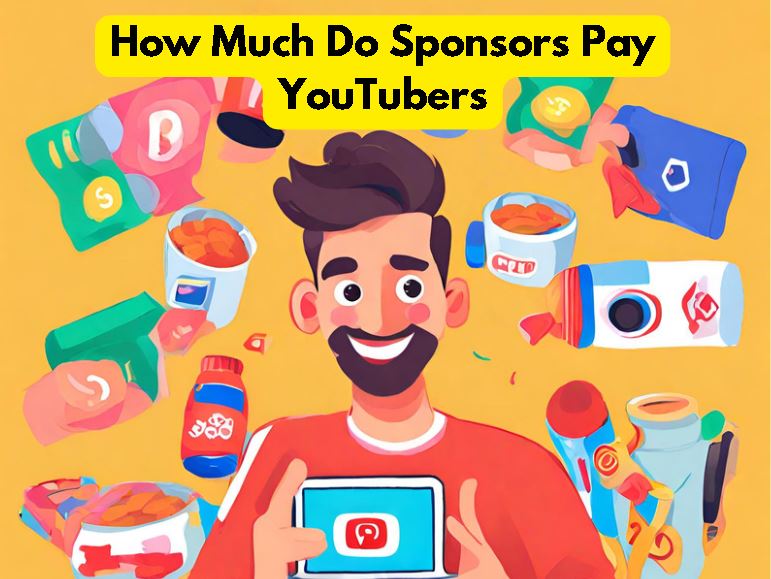YouTube sponsorships have become a pivotal revenue stream for content creators on the platform. As creators consistently deliver engaging content and amass substantial followings, brands are keen to tap into their audience for marketing purposes. Sponsorships typically involve a brand compensating a YouTuber in exchange for promoting their products or services through dedicated videos, mentions, or product placements. But how much do sponsors actually pay YouTubers? This is a complex question that depends on several factors, which we'll explore in detail below.
Factors Influencing Sponsorship Payments

When it comes to how much sponsors shell out to YouTubers, there’s no one-size-fits-all answer. Several key factors influence sponsorship payments, and understanding these elements can provide insight into the potential earnings for creators.
- Channel Size: The number of subscribers and views a YouTuber has can significantly impact payment. Generally, creators with larger audiences earn more, as they offer brands greater exposure. For instance:
Subscriber Range Average Payment 1,000 - 10,000 $100 - $500 10,000 - 100,000 $500 - $2,500 100,000 - 1,000,000 $2,500 - $25,000 1,000,000+ $25,000+ - Engagement Rate: Brands often look beyond sheer numbers; the level of engagement, such as likes, comments, and shares, plays a critical role. Higher engagement usually translates into better payments, as it indicates a loyal audience.
- Content Niche: The niche of the YouTube channel can also dictate sponsorship payments. Channels that align closely with a brand’s target demographic or industry may command higher rates. For example, tech and finance channels often attract higher sponsorship payments compared to lifestyle channels.
- Video Format: The format of the content matters too. Dedicated videos usually fetch higher prices compared to brief mentions in existing videos, as they provide more focused exposure for the brand.
- Brand Relationship: Established relationships between a brand and a YouTuber can result in greater sponsorship payments. Long-term collaborations are often more lucrative as brands recognize the value of consistent exposure.
In summary, sponsorship payments can vary widely depending on a range of influencing factors. By understanding these elements, both YouTubers and brands can better navigate the sponsorship landscape.
Types of Sponsorship Deals

When it comes to sponsorship deals in the world of YouTube, there’s a wide array of options available. Each type of deal caters to different content creators and their audiences. Let’s dive into the most common types:
- Direct Sponsorships: These are classic partnerships where a brand pays a YouTuber to create dedicated content featuring their products. This could be a review, a demonstration, or even a creative integration into the narrative. The upside? Direct engagement with the audience!
- Affiliate Marketing: Many YouTubers opt for affiliate deals where they promote a product and earn a commission for every sale made through their unique link. It’s a win-win situation; the YouTuber earns money, and the brands see their products reaching more potential customers.
- Sponsored Content: This involves brands sponsoring an entire video or series. For example, a travel vlogger could get sponsored by a suitcase company to showcase their product while traveling. It’s less intrusive and more narrative-driven than direct sponsorships.
- Brand Ambassadorships: Some YouTubers cultivate long-term relationships with brands, becoming their ambassadors. This often reflects a partnership that extends beyond a single video. The influencer regularly features the brand, creating a sense of trust and loyalty with their audience.
- Product Placements: This subtle approach involves incorporating a brand’s product organically within the video content. Think of a cooking vlog where the chef uses a specific kitchen gadget — viewers get the message without feeling overly marketed to.
Understanding these types can help YouTubers navigate their options and find the right fit for their channel and audience!
Average Earnings for YouTubers
So, how much are YouTubers really making? The answer varies significantly depending on various factors, but we can certainly paint a general picture.
On average, YouTubers earn between $3 to $10 per 1,000 views through ad revenue alone. Let's break it down:
| Earnings Per View | Estimated Earnings for 100,000 Views |
|---|---|
| $3 | $300 |
| $5 | $500 |
| $10 | $1,000 |
However, this is just part of the equation. Many successful YouTubers supplement their income through sponsorships, merchandise sales, and subscription models like Patreon – some even earn six figures or more!
Ultimately, earnings depend on factors such as:
- Audience Size: Larger audiences often lead to higher ad revenues and more engagement from brands.
- Content Niche: Certain niches, like finance or technology, typically have higher CPM (cost per mille) rates.
- Engagement Rate: A channel with a highly engaged audience can negotiate better sponsorship deals.
While it’s tempting to focus solely on the numbers, many YouTubers find fulfillment beyond financial gain. Creating content that resonates with their audience can lead to opportunities that money simply can’t buy!
How to Attract Sponsorships as a YouTuber
So, you’re a YouTuber, and you’re looking to snag some sponsorships? Great! Attracting sponsorships is key to turning your passion into profit. Here’s how you can get noticed by brands:
- Build a Strong Channel Identity: Define your niche and target audience. The clearer you are about who you are and what you offer, the easier it is for brands to see the potential fit.
- Create Engaging Content: Quality matters! Invest time in making your videos entertaining, informative, and appealing. Brands want to partner with creators who have a strong viewership.
- Grow Your Audience: Focus on growing your subscribers and views. Use social media to drive traffic to your YouTube channel, and engage with your followers to build a community.
- Network with Other YouTubers: Collaboration is key in the YouTube world. Working with others can expand your audience and attract the attention of potential sponsors.
- Showcase Your Value: Create a media kit that highlights your channel’s stats, audience demographics, and engagement rates. This provides brands with tangible proof of your worth.
Remember, brands are looking for alignment, so make sure your values and content resonate with the sponsors you want to attract.
Tips for Managing Brand Partnerships
Once you've attracted a sponsor, the real work begins! Managing brand partnerships is crucial for maintaining positive relationships. Here are some tips to help you navigate this:
- Clear Communication: Set expectations early. Discuss deliverables, timelines, and content guidelines to ensure you’re both on the same page.
- Stay Authentic: Always prioritize authenticity. Your audience values genuine content, so integrate brand messages in a way that feels natural and relatable.
- Track Performance: Keep track of how your sponsored content performs. Metrics like views, engagement, and comments will not only inform you but also provide valuable feedback for the brands.
- Set Boundaries: While it’s tempting to say yes to everything, too many partnerships can overwhelm you and dilute your content. Choose collaborations that match your brand and audience.
- Be Professional: Treat your partnerships like a business. Meet deadlines, respond promptly, and maintain a positive demeanor. A good rapport can lead to more opportunities down the line.
Effective brand partnership management can lead to long-lasting relationships and additional sponsorship opportunities in the future. So, manage wisely!
How Much Do Sponsors Pay YouTubers
YouTube sponsorships have become a lucrative revenue stream for many content creators. With an ever-growing audience on the platform, brands are increasingly inclined to collaborate with influencers to reach targeted demographics. However, the payment structure for sponsorships can vary widely based on several factors.
Some of the key factors that influence how much sponsors pay YouTubers include:
- Channel Size: Larger channels with millions of subscribers typically command higher sponsorship fees.
- Engagement Rate: Channels with a high engagement rate (likes, comments, shares) can negotiate better deals.
- Content Niche: Certain niches, such as tech or beauty, may attract higher sponsorship payments due to targeted demographics.
- Content Quality: High production quality and creativity can justify higher sponsorship fees.
Payments can also vary based on sponsorship types, which can be broken down as follows:
| Sponsorship Type | Typical Payment Range |
|---|---|
| Product Placement | $1,000 - $25,000+ |
| Dedicated Video | $2,000 - $20,000+ |
| Affiliate Deals | 5% - 30% commission on sales |
| Brand Ambassador | $10,000 - $100,000+ per year |
In conclusion, the earnings from YouTube sponsorships can vary greatly depending on a multitude of factors, including channel size, audience engagement, and niche. For YouTubers, understanding these variables can help them negotiate better deals and maximize their revenue potential.










